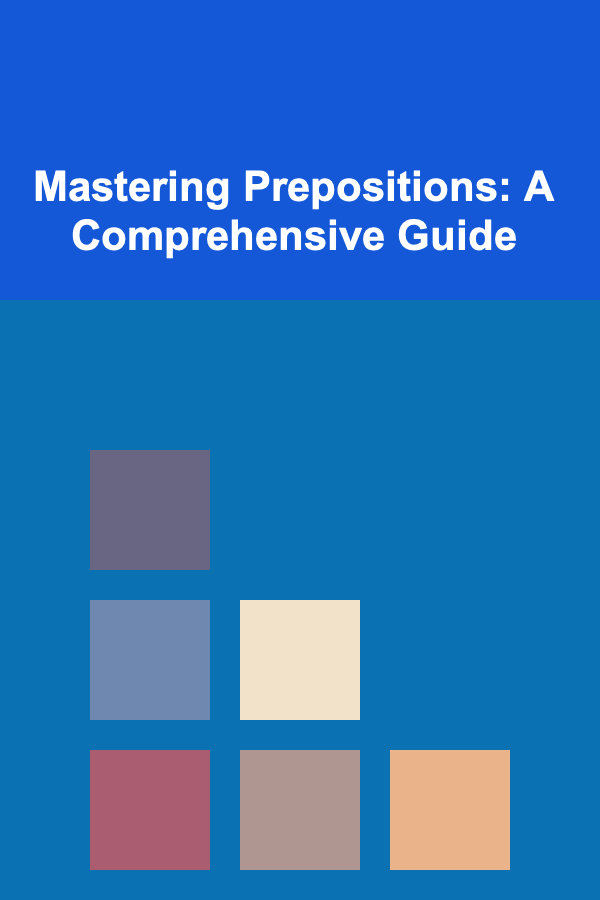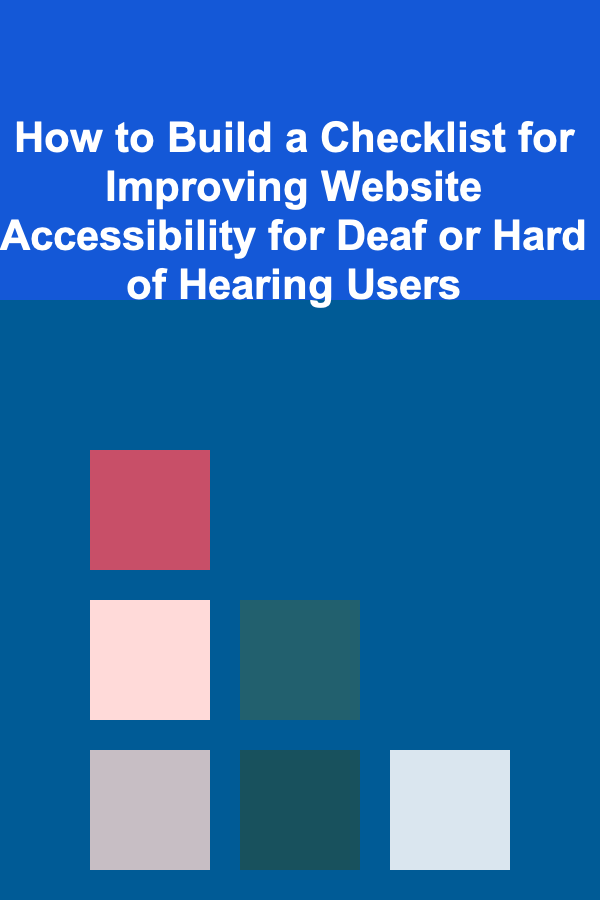
Mastering Prepositions: A Comprehensive Guide
ebook include PDF & Audio bundle (Micro Guide)
$12.99$11.99
Limited Time Offer! Order within the next:

Prepositions, those seemingly small words, play a monumental role in the English language. They connect nouns or pronouns to other words in a sentence, establishing crucial relationships of time, place, direction, and manner. Misusing a preposition can alter the meaning of a sentence, creating confusion or even humor. This comprehensive guide delves into the intricacies of prepositions, providing a thorough understanding of their usage and helping you to master this challenging aspect of English grammar.
Understanding the Basics
A preposition typically sits before a noun or pronoun, forming a prepositional phrase. This phrase acts as an adjective or adverb, modifying other words in the sentence. Identifying the relationship a preposition establishes is key to using it correctly. Let's break down the fundamental concepts:
What is a Preposition?
A preposition is a word that connects a noun or pronoun (called the object of the preposition) to another word in the sentence. It shows the relationship between the object and that other word. Common prepositions include: in, on, at, to, from, with, by, for, about, above, below, under, over, between, among, through, across, of, into, onto, towards, since, until, during, despite, because of, according to.
Consider these examples:
The book is on the table.
She walked to the store.
He is interested in learning new languages.
In the first sentence, "on" relates the book to the table, indicating its location. In the second, "to" connects "walked" to "store," showing direction. And in the third, "in" links "interested" to "learning," expressing a connection or concern.
Types of Prepositions
Prepositions can be broadly categorized based on the type of relationship they express:
- Prepositions of Time: Indicate when something happens (e.g., at, on, in, before, after, since, until, during).
- Prepositions of Place: Show where something is located (e.g., in, on, at, above, below, under, over, near, beside, between, among).
- Prepositions of Direction: Indicate movement or direction (e.g., to, from, into, onto, towards, through, across).
- Prepositions of Agent or Instrument: Specify the person or thing that performs an action (e.g., by, with).
- Prepositions of Purpose: Indicate the reason or intention behind something (e.g., for).
Common Prepositions and Their Usage
Let's examine some of the most frequently used prepositions and their nuances.
In, On, and At
These are perhaps the most common and most confusing prepositions. They are used to indicate both time and place, but their specific applications differ:
Prepositions of Time:
-
In: Used with periods of time (e.g., years, months, seasons, centuries, parts of the day).
I was born in 1990.We will visit Paris in the summer.
She studies best in the morning.
-
On: Used with specific days and dates.
The meeting is on Monday.Her birthday is on July 4th.
We will go hiking on the weekend.
-
At: Used with specific times and for periods that have a definite ending (like the weekend in some regions), or with places viewed as points.
The train arrives at 3:00 PM.He stayed at home all day.
I'll see you at lunchtime.
Prepositions of Place:
-
In: Used for enclosed spaces, large areas, or locations that are generally understood.
The keys are in the drawer.She lives in London.
He works in the garden.
-
On: Used for surfaces or when something is attached to a surface.
The book is on the table.There is a picture on the wall.
The stain is on the carpet.
-
At: Used for specific locations or points, or for events.
We met at the corner of the street.She is waiting at the bus stop.
I'll see you at the party.
Tip: Think of "in" as being inside something, "on" as being on top of something, and "at" as being at a specific point.
To, From, and For
These prepositions are often used to indicate movement, direction, and purpose.
-
To: Indicates direction or destination. It also shows a relationship of giving or receiving.
We are going to the beach.She gave the book to her friend.
He is addicted to coffee.
-
From: Indicates origin or source.
He is traveling from New York to Los Angeles.Where did you get that information from?
This gift is from my parents.
-
For: Indicates purpose, reason, or beneficiary.
This present is for you.She is studying hard for the exam.
I need money for groceries.
With and By
These prepositions are often used to describe instruments or agents of an action.
-
With: Indicates the instrument or tool used to perform an action or possession.
She wrote the letter with a pen.He cut the paper with scissors.
She is a girl with brown hair.
-
By: Indicates the agent or person performing the action, or proximity.
The book was written by a famous author.The house was built by the construction crew.
He stood by the door.
Above, Below, Under, Over
These prepositions describe relative positions in space.
-
Above: Higher than something else, not necessarily directly over it, and there may be a gap.
The clouds are above the mountains.The temperature is above average.
-
Below: Lower than something else.
The fish swim below the surface.The temperature is below freezing.
-
Under: Directly below something, often covered or concealed.
The cat is under the table.He hid the money under the mattress.
-
Over: Directly above, often implying movement or covering.
The plane flew over the city.She put a blanket over the baby.
Between and Among
These prepositions are used to indicate the relationship between multiple items.
-
Between: Used when referring to two distinct items or groups.
The agreement was between the two companies.There is a rivalry between them.
-
Among: Used when referring to three or more items or a non-distinct group.
She is popular among her classmates.The money was divided among the children.
Through and Across
These prepositions indicate movement from one side of something to the other.
-
Through: Implies movement within a defined space or enclosure.
The train went through the tunnel.She walked through the crowd.
-
Across: Implies movement from one side to the other, often over a surface or space.
He swam across the river.She walked across the street.
Prepositional Phrases
A prepositional phrase consists of a preposition and its object (a noun or pronoun) and any modifiers.
In the garden (in is the preposition, garden is the object).
On the big, wooden table (on is the preposition, table is the object, big and wooden are modifiers).
Prepositional phrases can function as adjectives or adverbs:
-
Adjective: Modifies a noun or pronoun.
The book on the table is mine. (The prepositional phrase "on the table" modifies "book"). -
Adverb: Modifies a verb, adjective, or another adverb.
He ran to the store. (The prepositional phrase "to the store" modifies "ran").She is happy about the trip. (The prepositional phrase "about the trip" modifies "happy").
Prepositions with Verbs (Phrasal Verbs)
Many verbs combine with prepositions or adverbs to create phrasal verbs. The combination often has a meaning different from the individual words.
Look up (to search for information): I need to look up the definition of that word.
Give up (to stop trying): Don't give up on your dreams.
Get over (to recover from): It took her a long time to get over the illness.
Phrasal verbs can be either separable or inseparable:
-
Separable: The object can be placed between the verb and the preposition.
He turned on the light. OR He turned the light on. -
Inseparable: The object must come after the preposition.
She ran into her friend. (Correct)She ran her friend into. (Incorrect)
Learning phrasal verbs requires memorization and practice. Pay close attention to context to understand their meaning.
Prepositions with Adjectives
Certain adjectives are commonly followed by specific prepositions. These combinations often have fixed meanings.
She is afraid of spiders.
He is good at playing the piano.
I am interested in learning new languages.
She is responsible for the project.
He is different from his brother.
Common adjective + preposition combinations include:
- Afraid of
- Aware of
- Capable of
- Dependent on
- Different from
- Excited about
- Famous for
- Good at
- Interested in
- Responsible for
- Similar to
- Worried about
It is crucial to learn these combinations to avoid errors in your writing and speech.
Prepositions with Nouns
Similar to adjectives, some nouns are also commonly followed by specific prepositions.
He has a need for attention.
She has a talent for music.
There is a solution to the problem.
He has an interest in history.
There is a relationship between the two companies.
Common noun + preposition combinations include:
- Access to
- Advantage of
- Cause of
- Confidence in
- Connection between
- Dependence on
- Effect on
- Example of
- Interest in
- Need for
- Relationship between
- Solution to
Again, learning these combinations is essential for accurate and natural English.
Common Errors with Prepositions
Even native English speakers sometimes make mistakes with prepositions. Here are some common errors and how to avoid them:
- Incorrect: "I am agree with you." Correct: "I agree with you." (The verb "agree" already implies "with," so the preposition is redundant when used directly with the verb).
- Incorrect: "Where are you at?" Correct: "Where are you?" (The "at" is often unnecessary and sounds informal. You can use it when more precision is needed: "Where are you at the mall?")
- Incorrect: "He is different than me." Correct: "He is different from me." ("Different from" is the standard usage, although "different than" is becoming increasingly common in American English).
- Incorrect: "Listen to me." Correct: "Listen to me." (The preposition "to" is required after "listen" when it has an object. However, you can say "Listen!" without the "to" if there's no specified object).
- Incorrect: "I am waiting you." Correct: "I am waiting for you." (The preposition "for" is required after "waiting" when it has an object).
- Incorrect: "He entered in the room." Correct: "He entered the room." (The verb "enter" already implies "in," so the preposition is redundant).
Another common error is ending a sentence with a preposition. While traditionally frowned upon, it's often grammatically acceptable and even natural in modern English, particularly in informal contexts. However, strive for clarity and conciseness. Sometimes rewording the sentence can avoid the preposition at the end without sounding awkward.
Acceptable: "What are you looking at?"
Rewritten (less natural): "At what are you looking?"
Better Rewritten (but with slightly different emphasis): "What is your object of attention?"
Tips for Mastering Prepositions
Mastering prepositions takes time and practice. Here are some tips to help you improve:
- Read extensively: Pay attention to how prepositions are used in different contexts. Notice the combinations with verbs, adjectives, and nouns.
- Listen carefully: Listen to native English speakers and observe their use of prepositions.
- Practice regularly: Do exercises and quizzes focusing on prepositions.
- Keep a notebook: Record common preposition combinations and phrasal verbs.
- Use a dictionary: Look up the definitions of prepositions and note their various meanings and uses. Pay attention to the example sentences.
- Don't be afraid to ask: If you're unsure about a particular preposition, ask a teacher, tutor, or native English speaker for clarification.
- Focus on context: The meaning of a preposition can change depending on the context. Pay attention to the surrounding words and phrases.
- Memorize common phrases: Learning common phrases with prepositions will improve your fluency and accuracy.
- Proofread your work: Carefully proofread your writing to catch any errors in preposition usage.
- Use online resources: Many websites and apps offer lessons and exercises on prepositions.
Conclusion
Prepositions are a fundamental part of English grammar. While they can be challenging, understanding their usage is essential for clear and effective communication. By studying the rules, practicing regularly, and paying attention to context, you can master prepositions and improve your overall English proficiency. Remember to focus on the relationships prepositions create between words, and don't be afraid to ask questions when you're unsure. Good luck!

10 Clever Tips for Saving Money on Pet Food and Supplies
Read More
How to Build a Checklist for Improving Website Accessibility for Deaf or Hard of Hearing Users
Read More
How to Set Up an Efficient and Stylish Home Bar for Your Party
Read MoreHow to Understand AR Tracking Technologies
Read More
How to Understand Weather Patterns for Outdoor Trips
Read More
How To Understand the Psychology of Visuals
Read MoreOther Products

10 Clever Tips for Saving Money on Pet Food and Supplies
Read More
How to Build a Checklist for Improving Website Accessibility for Deaf or Hard of Hearing Users
Read More
How to Set Up an Efficient and Stylish Home Bar for Your Party
Read MoreHow to Understand AR Tracking Technologies
Read More
How to Understand Weather Patterns for Outdoor Trips
Read More